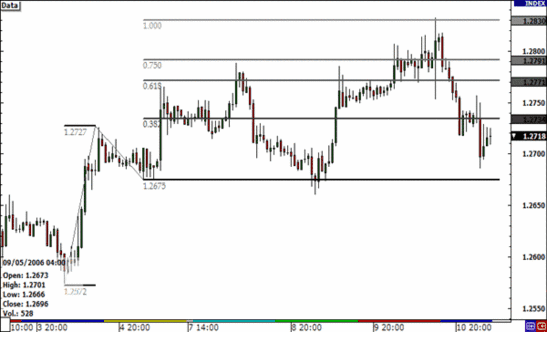Forex trading strategies for using the Fibonacci Extension: Techniques for trading with the Fibonacci Extension levels.
In the fast-paced world of forex trading, traders are constantly seeking tools and strategies that can provide them with a competitive edge. One such tool that has gained popularity among traders is the Fibonacci Extension. Derived from the famous Fibonacci sequence, the Fibonacci Extension levels offer traders a systematic approach to identifying potential price targets and making informed trading decisions. In this article, we will explore various techniques for effectively using Fibonacci Extension levels in forex trading strategies.
Table Content
I. Understanding the Fibonacci Extension
II. Fibonacci Extension Trading Techniques
1. Identifying Trends and Reversals
2. Combining with Other Technical Indicators
3. Setting Stop Loss and Take Profit Levels
4. Confluence of Fibonacci Levels
5. Using Fibonacci Extensions in Multiple Timeframes
6. Practice and Back testing
III. Footnote
Understanding the Fibonacci Extension:
Before delving into trading techniques, it's crucial to understand what the Fibonacci Extension is and how it works. The Fibonacci sequence is a series of numbers in which each number is the sum of the two preceding ones, typically starting with 0 and 1. The sequence goes: 0, 1, 1, 2, 3, 5, 8, 13, 21, and so on.

The Fibonacci Extension levels are a set of horizontal lines drawn on a price chart that indicate potential areas of support and resistance beyond the usual price retracement levels. These levels are calculated using the Fibonacci sequence and are typically drawn at 1.618, 2.618, 4.236, and so forth, times the retracement distance.
Fibonacci Extension Trading Techniques:
1. Identifying Trends and Reversals:
Fibonacci Extension levels can be highly effective in identifying potential trend continuation points as well as reversal zones. When a currency pair is in a strong uptrend or downtrend, traders can draw Fibonacci retracement levels from the recent swing low to high (for an uptrend) or from high to low (for a downtrend). Once these retracement levels are identified, Fibonacci Extension levels can be applied to project potential areas of price extension where the trend might continue. Traders should pay close attention to these extension levels as they could act as key support or resistance points, indicating potential price reversals.
2. Combining with Other Technical Indicators:
While Fibonacci Extension levels can be powerful on their own, combining them with other technical indicators can enhance their effectiveness. Traders often use moving averages, trendlines, and oscillators like the Relative Strength Index (RSI) or Moving Average Convergence Divergence (MACD) to validate the signals provided by the Fibonacci Extension levels. When multiple indicators align with a particular extension level, it strengthens the case for a trade, providing traders with added confidence.
3. Setting Stop Loss and Take Profit Levels:
One of the key advantages of using Fibonacci Extension levels is their ability to assist in setting optimal stop loss and take profit levels. When a trader enters a position based on a Fibonacci Extension level, they can place their stop loss just below or above the extension level to manage risk. Similarly, they can set their take profit target at the next Fibonacci Extension level or other relevant resistance/support levels. This technique helps traders maintain a favorable risk-to-reward ratio while allowing for potential price extension movements.
4. Confluence of Fibonacci Levels:
Confluence occurs when multiple Fibonacci Extension levels cluster around the same price area. This convergence of levels strengthens the significance of that particular zone as a potential turning point. Traders should watch for these areas of confluence, as they often lead to increased market volatility and potential trading opportunities. For instance, if a 1.618 Fibonacci Extension level coincides with a major trendline or a previous support/resistance level, it provides a stronger signal for a potential trade.
5. Using Fibonacci Extensions in Multiple Timeframes:
To enhance the accuracy of trading signals, traders can analyze Fibonacci Extension levels across multiple timeframes. A Fibonacci Extension level that aligns on various timeframes, such as the daily and weekly charts, carries more weight than a level identified on a single timeframe. This technique helps traders identify significant price levels that have a broader impact on the market.
6. Practice and Back testing:
As with any trading strategy, practice and back testing are essential when using Fibonacci Extension levels. Traders should apply these techniques to historical price data to assess how well they would have performed in the past. This process helps traders fine-tune their entry and exit strategies and gain a better understanding of the market behavior around these extension levels.
Footnote:
In the realm of forex trading, mastering various strategies is crucial for success. The Fibonacci Extension levels offer traders a systematic and mathematically sound approach to identifying potential price targets and making informed trading decisions. By understanding how to identify trends, combining these levels with other technical indicators, setting appropriate stop loss and take profit levels, recognizing areas of confluence, and analyzing multiple timeframes, traders can harness the power of Fibonacci Extension levels to their advantage.
However, it's important to note that while Fibonacci Extension levels can provide valuable insights, no trading strategy is foolproof. Market conditions can change rapidly, and traders should always exercise prudent risk management and use these techniques in conjunction with other forms of analysis. As the forex market continues to evolve, traders who integrate Fibonacci Extension levels into their trading arsenal can potentially gain an edge in their quest for consistent profitability.











Discussion